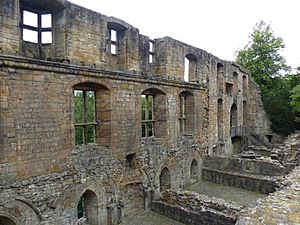John Norlie facts for kids
John Norlie was an English musician who lived around the late 1500s and early 1600s. He played music for the Scottish royal family, especially for Anne of Denmark, who was the Queen. Not much is known about where he grew up or how he learned music.
Norlie played two instruments: the lute and the viol. These were popular string instruments back then. Sometimes his name was written as "John Orley" in official papers.
Contents
Working for the Royal Family
In 1599, John Norlie started working for King James VI. He received a good yearly salary of £1,000 Scots. This was a lot of money! But there was a condition: he had to hire and support four other musicians. These musicians had to be ready to play for the King whenever needed.
By 1601, Norlie was mostly working for Anne of Denmark, the Queen. He even signed a receipt saying he was "musicinar to the quenis majestie" (musician to the Queen's majesty).
Moving to London
When King James VI became King of England in 1603, he moved his court to London. This event is known as the Union of Crowns. John Norlie went with Queen Anne to London. Records show he was still working for the Queen in 1604.
In 1607, Norlie returned to Edinburgh, Scotland. The city council hired him to lead a band of four expert musicians. They were supposed to play instruments like the shawm and oboe every day. His band even wore special silver badges! Norlie was to be paid 100 merks each year. The Queen's goldsmith, George Heriot, made the badges. However, it seems this plan for the band didn't fully happen.
The Queen's Music
Queen Anne of Denmark loved music. In 1599, a visitor to Holyrood Palace heard music coming from her room. She had her own group of musicians, including some from Denmark. These Danish musicians later returned home in 1614.
The Queen also had other musicians and staff. Thomas Cardell and an Italian musician named John Maria Lugario worked for her. Lugario even wrote out music for the Queen and bought songbooks.
Queen Anne's Instruments
Queen Anne played several instruments herself. She played the virginals, which was a type of keyboard instrument. She also played the lira, a string instrument, and a wind instrument. A person named Robert Henlake helped supply and take care of her instruments.
Royal Entertainment
Queen Anne enjoyed putting on shows and masques. These were special performances with music, dancing, and costumes. In 1618, her musicians put on a small masque for her at Somerset House.
She also staged a masque called Prince Henry's Welcome at Winchester in 1603. In Scotland, Queen Anne and King James VI bought costumes for masques. These were often performed at the weddings of the Queen's ladies-in-waiting.
Family Life
John Norlie and his wife, Dorothy Lokie, had children. Queen Anne often stayed at Dunfermline Palace. The church records there mention Norlie as "John Orliance" or "John Orlie, violer to her majestie."
His son Frederick was baptized in December 1600. His daughter Anna was baptized in January 1602. Another son, also named Frederick, was baptized in February 1603 in Canongate, Edinburgh. For this baptism, Norlie was recorded as "Jhone Norlie master violer to her majestie." Important people like the King himself and John, Master of Erskine, were witnesses at the baptism.


